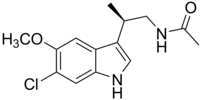TIK-301
 | |
| Clinical data | |
|---|---|
| Other names | Beta-methyl-6-chloromelatonin; LY-156735; PD-6735 |
| Routes of administration | Oral |
| Legal status | |
| Legal status |
|
| Pharmacokinetic data | |
| Elimination half-life | 1 hour |
| Identifiers | |
| |
JSmol) | |
| |
| |
| | |
TIK-301 (LY-156735) is an agonist for the melatonin receptors MT1 and MT2 that is under development for the treatment of insomnia and other sleep disorders.[1] Its agonist action on MT1 and MT2 receptors in the suprachiasmatic nucleus in the brain enables its action as a chronobiotic. It is in the same class of melatonin receptor agonists as ramelteon and tasimelteon.
History and development
TIK-301 was first developed at
TIK-301 was in phase II
Pharmacodynamics
TIK-301 is a high affinity nonselective MT1/MT2 agonist.
Pharmacokinetics
TIK-301 is administered orally.[14] Compared to melatonin, it has nine times greater bioavailability and six times greater area under the curve (AUC), which means the body retains more of an administered dose.[13][14] TIK-301 was detected in blood plasma within 10 to 15 minutes of administration of a single oral dose and remains in a patient's system until 12 hours after the single dose.[13] Plasma concentrations increased rapidly and peaked at 1 hour after the dose, independent of dose size.[13] TIK-301's half-life is about 1 hour.[9][13] This extended half-life may be partially due to the chlorine in its structure.[11] Elimination constants depended on dose, 20 mg dose had a different elimination constant from all other doses above 35 mg.[13]
Treatment
TIK-301 is intended to be a take-as-need drug for
In addition to a sleep aid, TIK-301 has been found useful in treating other disorders. Because of its affinity for serotonin receptors, it has potential to serve as a possible antidepressant drug, similar to agomelatine.[8][9][19] TIK-301 has also been considered for use in patients with mild cognitive impairment (MCI) because of sleep disorder prevalence.[15] TIK-301, as well as other melatonin agonists, has been reported to have potential in preventing or treating urinary incontinence, but have not been tested in humans for this purpose.[20][21] It is also seen as a potential therapeutic agent for spinal cord injury (SCI); in low doses (10 mg/kg) it was seen to be benefit in rats after SCI, but in higher doses (100 mg/kg), it proved toxic.[22]
Side effects
There were no major and serious side effects in phase I trials, and mild side effects such as diarrhea, conjunctivitis and laryngitis were observed in few cases.[14][16] Unlike benzodiazepines sleep medications, TIK-301's novel mode of action at melatonin receptors reduce many common side effects of sleep medications like dependency. In addition, TIK-301 had no latent, morning after psychomotor impairments.[16] A few patients reported cases of somnolence in clinical trials, which is consistent with the drug's soporific effects.[13]
Because of its receptor specific action, there are no associated changes in core body temperatures, heart rate or blood pressure as with other melatonin medications.[13][15][16][17]
References
- ^ "PD-6735, LY-156735,118702-11-7,C14-H17-Cl-N2-O2,N-[2(R)-(6-C--药物合成数据库". Archived from the original on 2009-09-27.
- ^ PMID 18673165.
- ISBN 978-1-60805-159-5.
- ^ "Phase 2 Discovery, Inc. Acquires Drug in Clinical Development to Treat Sleep Disorders". Phase 2 Discovery, Inc. Acquires Drug in Clinical Development to Treat Sleep Disorders. Archived from the original on 2016-10-30. Retrieved 15 March 2015.
- ^ "Tikvah Therapeutics Signs Agreement to Develop and Commercialize LY156735, a Second Generation Melatonin Agonist, for Circadian Rhythm and Sleep Disorders". Nasdaq Global Newswire (Press release). 2007-08-29.
- PMID 25937968.
- ^ "Phase 2 Discovery, Inc. Receives Orphan Drug Designation From FDA For Synthetic Melatonin Analog PD-6735". BioSpace. 19 October 2005. Archived from the original on 4 March 2016.
- ^ PMID 22680635.
- ^ PMID 25258560.
- PMID 24228714.
- ^ PMID 22640220.
- ^ PMID 23131177.
- ^ PMID 15302228.
- ^ S2CID 10363563.
- ^ S2CID 139480.
- ^ PMID 15766306.
- ^ PMID 15511698.
- PMID 17824497.
- ^ "PRESS RELEASE: Tikvah Therapeutics Signs Agreement with Phase 2 Discovery". fiercebiotech.com. 29 August 2007. Archived from the original on 2018-11-01. Retrieved 7 April 2015.
- S2CID 19644131.
- ^ WO 2014010603, Watanabe K, Kawabata Y, Watanabe K, Yuyama N, Burgard S, Bruce E, "Pharmaceutical composition for treatment or prevention of stress urinary incontinence or mixed urinary incontinence, and screening method for compounds contained in the pharmaceutical composition", published 16 January 2014, assigned to Astellas Pharma Inc.
- S2CID 27784753.
